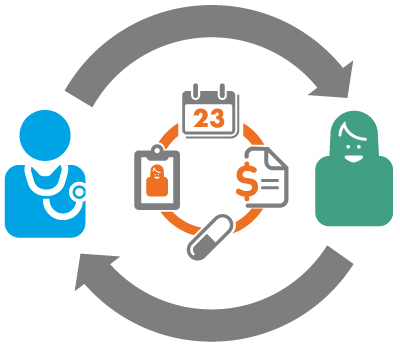Blog Articles
Wednesday, April 15th, 2015
written by Chelsea Overstreet

While at HIMSS15 in Chicago this week, a SBMI alumna, Shannon Vogel, presented on the topic of patient engagement and what tools physicians can use to help improve the patient engagement practices they utilize. HealthcareITNews.com recently noted that “consumers are expecting consumer-quality experiences in healthcare” and advances in physician and patient engagement are important in working towards enhancing those experiences.
A 2013 report by the Workgroup for Electronic Data Interchange (WEDI) defined patient engagement as “dialogue between patients and key healthcare stakeholders.” At its core, patient engagement is about the action of the patient regarding their own care.
Increases in the dialogue between both the patients and their physicians benefits both parties. In recent years, patients have taken a more active, involved role in their healthcare so increasing the lines of communication with their physicians is critical. For physicians, the more interaction they have with their patients, the more knowledge they can gain about their preferences for the amount of information they want to receive.
In a 2012 survey, Pew Research Center found that “72% of internet users looked online for health information within the past year.” With the rate at which technology is growing, that percentage has likely swelled during the last three years. For the three of four internet users who have searched for health information, we typically see that those patients want email reminders, online scheduling options, the ability to email their physicians and access to their health records & test results. However, usage of portals that offer access to this type of information varies greatly by patient demographic.
For ambulatory physician practices, the patient portals are an opportunity to save on administrative costs. Additionally, patient engagement is one of the five meaningful use goals. The Stage 1 patient engagement requirements are:
Stage 2 patient engagement criteria are:
For physicians, there are a variety of tools they can use to increase patient engagement including health information exchanges (HIE), personal health records (PHR) and patient portals, which are the most commonly used tools. Each resource has both pros and cons, so physicians should work directly with providers to evaluate the systems thoroughly and to determine if they are sufficient. While using the tools, physicians need to first acclimate their patients to the system and then survey them after implementation to assess their level of satisfaction and determine what shortcomings need addressing.
Because patient engagement is an emerging topic, the tools used to enhance the experience for patients are evolving. Physicians may be apprehensive when it comes to sharing too much information outside of the practice environment and that is understandable. Ultimately, physicians need to keep in mind that access to personal health information must be balanced with patient preferences and HIPAA compliance.
To review all of Shannon’s slides on physician tools for patient engagement, visit the HIMSS15 conference website.